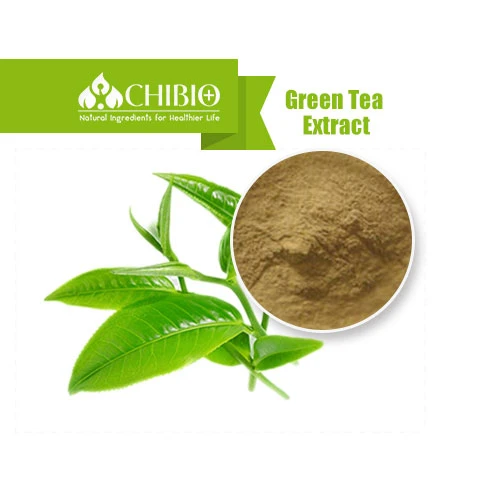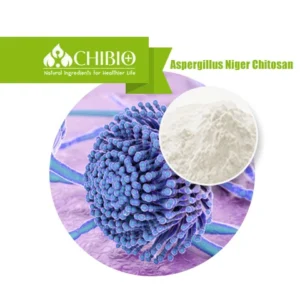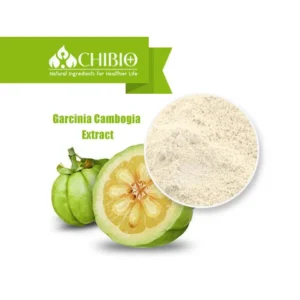Green Tea Extract
Product Details

Green tea extract is an active ingredient extracted from green tea leaves, mainly including tea polyphenols (catechins), caffeine, aromatic oils, moisture, minerals, pigments, carbohydrates, proteins, amino acids, vitamins and the like.
Tea polyphenols have anti-oxidation, scavenging free radicals, etc., and significantly reduce the serum total cholesterol, triglyceride, low-density lipoprotein cholesterol content of hyperlipidemia, and at the same time have the effect of restoring and protecting vascular endothelial function. The hypolipidemic effect of tea polyphenols is also one of the main reasons why tea can make obese people lose weight without rebounding.
Green tea extract is derived from leaves of camellia sinensis, the plant from which green, black and oolong teas are made. It is associated with several health benefits, many supported by preliminary scientific research. This includes potential cancer-fighting properties, and a strong antioxidant effect that protects the body from the damaging effect of free radicals. The scientific community notes, however, that continued research is necessary.
Green tea has been used for medicinal purposes in India and China for nearly 5,000 years. It is made by lightly steaming the leaves before allowing them to dry, which helps retains the active properties of the plant. Oolong tea is made by allowing the leaves to ferment slightly before drying, and black tea is made by allowing the leaves to ferment longer. Fermentation breaks down the active ingredients, making green tea or its extract the tea of choice.

How it works?
Green Tea Polyphenols (GTP) is the main component of green tea, which accounts for about 30% of dry matter. GTP is extracted from tea and its by-products (tea, tea, coarse tea or pruned leaves). Since it was extracted only with food grade ethyl acetate, the original structure of GTP was retained and the product was a pale yellow powder. The main component is composed of catechin, which accounts for 60%~80% of the total GTP, including 4%~6% of epicatechin (L-EC) and 6%~8% of gallocatechin (DL). -EC), 10% to 15% epigallocatechin (L-EGC), 50% to 60% epigallocatechin gallate (L-ECG), and 8% to 10% caffeine.
The GTP structure is rich in phenolic hydroxyl groups, which can provide active hydrogen to inactivate free radicals, and the free radicals formed by oxidation itself have higher stability due to the catechol structure. Therefore, GTP has the function of scavenging free radicals and inhibiting lipid peroxidation.
Specification of Green Tea Extract
| Product Name | Green Tea Extract 15%-98% |
| Part of used | Leaf |
| Active ingredient | Polyphenols & EGCG & Catechins |
| Specs Available | 1.Total tea polyphenols: 60%- 98% 2.Total tea catechins: 40%- 90% 3.EGCG: > 20%-70% |
| Odor | Characteristic |
| Appearance | Slight yellow brown powder |
| Sulphated Ash | <1.0% |
| Loss on drying | <3.0% |
| Total Plate Count | <1000cfu/g |
| Yeast&Mold | <100cfu/g |
| E.Coli | Negative |
| Salmonella | Negative |
| S.Aureus | Negative |
| Pesticides | Negative |
| Shelf life | 2 years |
| Package | 25kg/fiber drum |
| Storage | Store in cool and dry places. Keep away from strong light. |

Benefits & Applications of Green Tea Extract
It’s a great alternative to coffee for that caffeine buzz, since each cup contains anywhere between 35-100 milligrams of caffeine, depending on how long it’s been steeped. Green tea is also a great source of antioxidants—called catechins—that help support immune function, cardiovascular health, and fat loss. Above all, green tea just goes really, really well with sushi.
Numerous epidemiological studies show that regular consumption of green tea has a net positive effect on overall health. Even as a supplement, green tea can be a worthwhile addition to your dietary habits, especially if your goal is fat loss. The primary difference between drinking tea and taking it in pill form is dosage. In supplement form—depending on the brand and processing—the dosage is typically much higher.
If you are interested in taking green tea extract supplements, here are a couple of things you should note:
1.Dietary Supplement for Health

[Reducing blood lipids]: Tea polyphenols can significantly reduce the serum total cholesterol, triglyceride, low-density lipoprotein cholesterol content of hyperlipidemia, and at the same time have the effect of restoring and protecting vascular endothelial function. The hypolipidemic effect of tea polyphenols is also one of the main reasons why tea can make obese people lose weight without rebounding.
[Antioxidant effect]: Tea polyphenols can block the lipid peroxidation process and increase the activity of enzymes in the human body, thereby exerting anti-mutation and anti-cancer effects.
[Inhibition of tumor effects]: Tea polyphenols can inhibit the synthesis of DNA in tumor cells and induce the cleavage of mutant DNA, thereby inhibiting the synthesis rate of tumor cells and further inhibiting the growth of tumor growth.
[Bactericidal and detoxification]: Tea polyphenols can kill botulinum and spores and inhibit the activity of bacterial exotoxin. It has an antibacterial effect on various pathogenic bacteria that cause diarrhea, respiratory tract and skin infections. Tea polyphenols have obvious inhibitory effects on Staphylococcus aureus and mutant bacilli causing purulent infection, burns and trauma.
[Detoxification and protection of the liver]: Alcoholic liver injury is mainly caused by free radical damage caused by ethanol. Tea polyphenols act as free radical scavengers and have the effect of inhibiting alcoholic liver damage.
[Clearing effect]: Severe environmental pollution has obvious toxic effects on human health. Tea polyphenols have strong adsorption to heavy metals and can form complexes with heavy metals to form precipitates, which is beneficial to reduce the toxicity of heavy metals to human body. effect. In addition, tea polyphenols also have the effect of improving liver function and diuresis, and thus have a better anti-lysis effect on alkaloid poisoning.
[Improve the body’s immunity]: Tea polyphenols can improve the overall immunity of humans by increasing the total amount of human immunoglobulin and maintaining it at a high level, thereby promoting the body’s own conditioning function.
2.Fat Burning for weight-loss

Green tea extract is rich in catechins, and it contains a decent amount of caffeine.
Interestingly, it seems that this combination of ingredients is responsible for its weight loss properties.
Both catechins and caffeine have been shown to assist in weight loss by regulating the hormones that can enhance thermogenesis.
Thermogenesis is the process by which your body burns calories to digest food and produce heat. Green tea has been shown to boost this process by making your body more effective at burning calories, which can lead to weight loss.
One study had 14 people take a capsule containing a mixture of caffeine, EGCG from green tea and guarana extract before each meal. It then examined the effect on calorie burning.
It found that the participants burned 179 more calories, on average, in the following 24 hours.
Another study showed that 10 healthy men burned 4% more calories during the 24 hours after consuming a green tea extract capsule containing 50 mg of caffeine and 90 mg of EGCG.
What’s more, a 12-week study that had 115 overweight women take 856 mg of green tea extract daily observed a 2.4-lb (1.1-kg) weight loss among participants.
Green tea extract can aid weight loss by increasing the number of calories your body burns through thermogenesis.

3. Food benefits & Others

Tea polyphenols have been widely used in the food industry as a natural antioxidant. China’s food additives use standards, tea polyphenols can be used in the use of oils, moon cakes, ham and other foods, the amount is 0.4g / kg. It is used by first dissolving it in ethanol, adding a certain amount of citric acid to form a solution, and then applying it to the food by spraying or adding.
[Meat products]: Meat and its products often turn yellow due to the automatic oxidation of fat during storage, and appear rancid. In the processing of meat products, the various tea products are soaked or sprayed with the prepared tea polyphenol solution, which can form a gas-impermeable hard film on the surface of the meat product and the tea polyphenol, thereby inhibiting the oxidation and rancidity of the meat product surface. Bacterial growth and good results in preventing spoilage.
[Eating Animal and Vegetable Oils and Fats]: Animal oils are highly susceptible to auto-oxidation and deterioration because they do not contain natural antioxidants. Adding tea polyphenols to oils and fats can prevent and delay the automatic oxidative decomposition of unsaturated fatty acids, effectively inhibit the oxidative rancidity of oils and fats, and prolong its storage period.
[Fried food]: During the frying process, fried foods become darker and darker due to oxidation; in the storage, as the oxidative rancidity of the oil gradually deepens, the aroma and flavor of the product are seriously affected. Tea polyphenols have better antioxidant effects on fried foods, which can delay the oxidative rancidity and improve the shelf life of foods.
[Baked food]: In the production of moon cakes and other oil-containing foods, adding tea polyphenols to the mixture of flour and oily articles can not only solve the antisepsis of these foods, but also play a role in nutrition health care and food flavor enhancement.
[Aquatic products]: Tea polyphenols have significant anti-oxidation, anti-corruption and anti-browning effects in the preservation and processing of aquatic products such as fish and shrimp. When making dried fish products, the water product is impregnated with water containing tea polyphenols to prevent yellowing and lipid oxidation of dried fish due to “oil burning”. When frozen fresh fish, the addition of tea polyphenols can also make fish fresher.
[Beverage]: Tea polyphenols can be used to prepare various tea beverages, which can be applied to various alcoholic beverages, and can also inhibit the destruction of vitamin A and vitamin C in soy milk, soda, juice and other beverages, thereby protecting the beverage. a variety of nutrients.
[Candy Food]: Tea polyphenols are applied to candy such as chewing gum, candy, fruit candy, etc., which can effectively resist oxidation and preservation, solid color and fragrance, and eliminate bad breath. In addition, tea polyphenols can also make the “acid tail” in high-sugar foods disappear, making the taste sweet.






